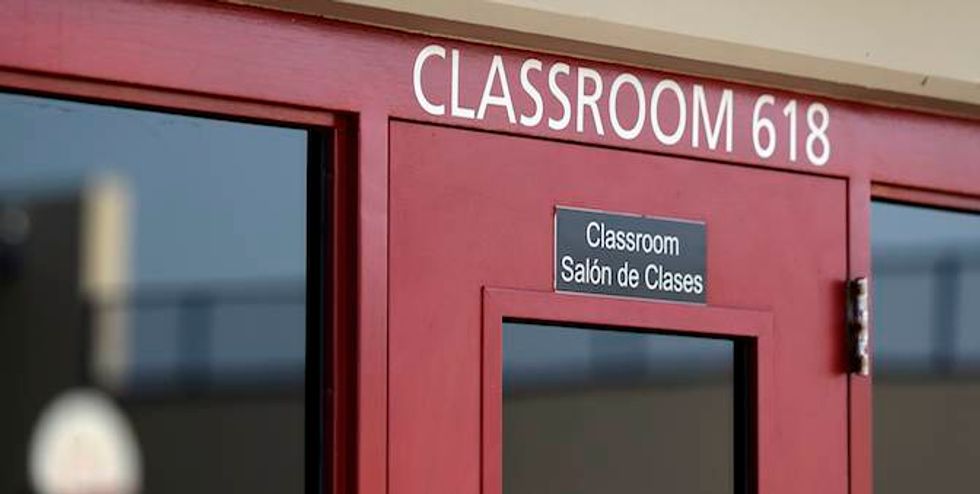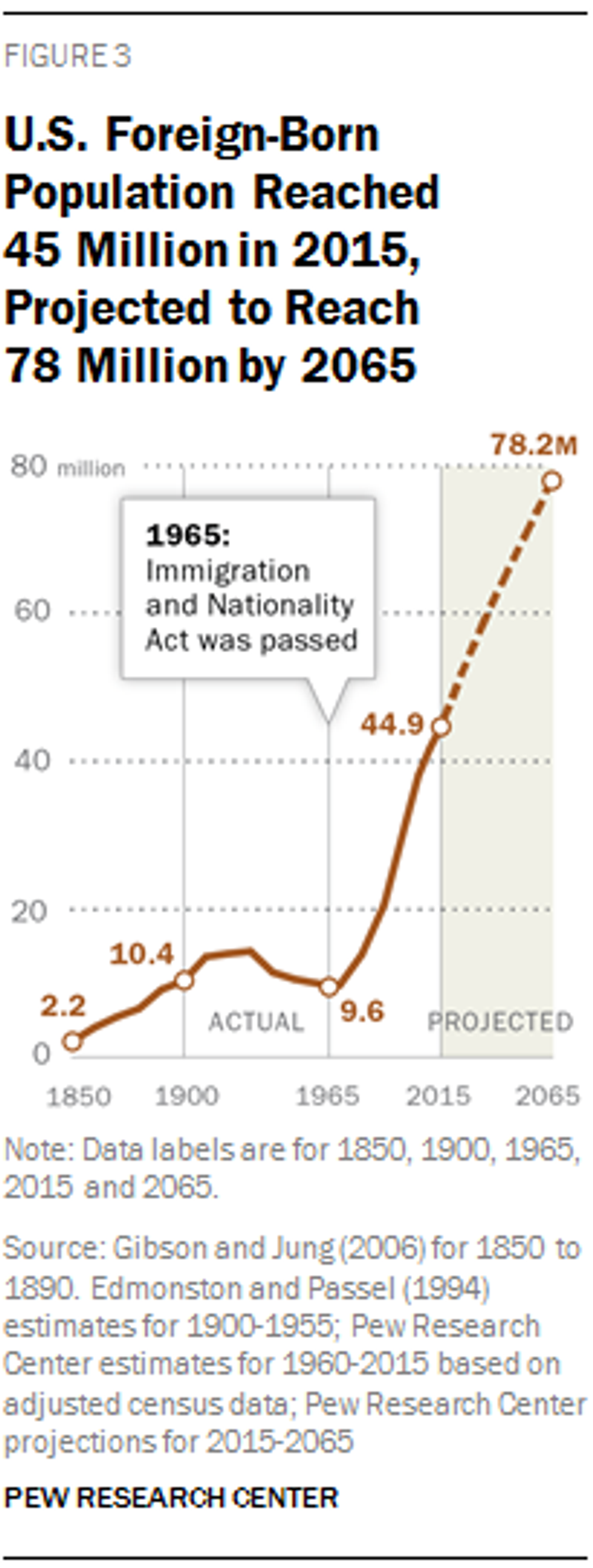
© 2025 Blaze Media LLC. All rights reserved.
This week marks the 50th anniversary of the 1965 “Hart-Cellar” immigration act, commonly referred to as “the Kennedy Immigration bill.” At the time, the bill was sold as a modest increase in immigration from the four decades of low immigration and some blatantly discriminatory policies. Americans were ensured that the bill would not fundamentally alter the character – political, social, or fiscal – of this country. At the time, Rep. Patsy T. Mink (D-HI) estimated, on average, less than 200,000 immigrants would be admitted per year and predicted that 82% would come from Europe. Attorney General Nicholas Katzenbach predicted the bill would induce a net increase of about 60,000 immigrants per year. [See CIS for more fascinating quotes and promises from political leaders at the time.]
A half century later, this bill turned out to be the most consequential piece of legislation in modern times and has irrevocably transformed America. Moreover, according to a new comprehensive analysis of immigration trends from Pew Hispanic, we have not even witnessed the peak from this unprecedented wave of immigration.
This blockbuster Pew report exposes trends in immigration that are not only antithetical to anything our Founders envisioned as it relates to immigration, but run contrary to a number of promises given by supporters of the 1965 immigration bill. As you read these statistics, keep in mind that nobody ever voted for this transformation in a transparent manner. Also remember, that these numbers are the reality under current law and the existing trajectory – the very system the majority of the political class deems too restrictive.
The top 9 shocking immigration statistics from this Pew report:
1. Current Immigrant Population:
Almost 59 million immigrants have come to America since passage of the 1965 bill. At present, there are a record 45 million immigrants in the country, accounting for almost 14% of the population. In 1965, there were just 9.6 million immigrants, accounting for 4.8% of the total population.
2. Magnitude of Current Wave of Immigration:
The 59 million-strong immigration wave dwarfs the 14.3 million immigrant wave during the “old immigration” of Germans and Irish in the mid-1800s and even the 18.2 million of the great wave from 1890-1919.
3. Projected Immigration:
The existing record wave of immigration is just the beginning. By 2065, the immigrant population is projected to rise to 78 million, representing 17.7% of the population and accounting for 88% of total population growth. The combined population share of immigrants and their U.S.-born children will account for 36% of the entire population, up from the already high 26% of the American pie.
4. Origin of Immigration:
Since 1965, 51% of all immigrants have come from Latin America, 30% from Mexico alone. In 1910, 89% of immigrants were from Europe; today that number is just 10%.
5. Ethnic/Racial Transformation:
None of the previous waves of immigration changed the racial orientation of the country and only induced a small shift in ethnic composition. Not so, with the current great wave. In 1965, 84% of Americans were “non-Hispanic whites” and 4% were Hispanic. Now, just 62% are white and 18% are Hispanic. In 30 years, whites will represent just half of the population and by 2065 they will slide to just 46% of the general population. While we celebrate all sorts of ethnicities and races assimilating into American culture, nobody ever advertised the 1965 bill as a means of making whites a minority. In fact, Kennedy famously promised, "It will not upset the ethnic mix of our society."
6. Background of Immigrants:
In 1965, 80% of immigrants were white; now just 18% are white, roughly half are Hispanic and a quarter are “Asian” (this includes the Far East as well as the Middle East in Asia).
7. Immigrant Income:
While median adjusted family income of native Americans has risen from $46,611 in 1970 to $60,872 in 2013, immigrant families have seen a slight dip in income overall from $40, 935 to$39,567, despite the fact that immigrants have not been as negatively affected by the past decade of wage stagnation as native-born Americans.
8. Poverty:
In 1970, the poverty rate among immigrants stood at 18%, only slightly higher than the 14% of the native-born population. Now the poverty rate among immigrants has grown to 28% compared to 15% among Native Americans.
9. Biased Towards Mexico:
As of 2010, Mexicans were the largest immigrant group in 33 states, with immigrants from other Latin American countries winning first place in 6 other states. At the height of the first great wave in 1910, on the other hand, Germans held the distinction of the most represented immigrant group in just 17 states.
Americans have always been welcoming to people of all backgrounds who want to come here, cherish our constitutional republican values, assimilate into our culture, and become a net contributor. Every immigration act, including the infamous 1965 bill, was sold to the people as a system that would not become a fiscal drain, fundamentally alter the country’s political or cultural values, or overwhelm the native population.
Not surprisingly, according to Pew, the American people are not happy with this social transformation without representation (a theme central to my upcoming book on this topic). Just 15% share the view of the political elites that we should increase our record-high levels of immigration and half of Americans want it decreased. An overwhelming majority of Americans feel immigrants are not assimilating like they used to.
The bottom line is that Americans appreciate immigration, but like every other policy the devil is in the details. And those details were hidden from the people with the passage of the 1965 Act. They have been completely disenfranchised about the most consequential decision of our time – the future membership of the civil society.
Thomas Jefferson, writing in Notes on the State of Virginia, echoed a sentiment widely held by almost all of the Founders when he welcomed immigrants in moderation that would become net contributors and assimilate into “republican” values. But he warned about mass migration, and mind you, he was referring to European immigrants and a time when the country dramatically needed to populate its frontier:
Suppose 20 millions of republican Americans thrown all of a sudden into France, what would be the condition of that kingdom? If it would be more turbulent, less happy, less strong, we may believe that the addition of half a million of foreigners to our present numbers would produce a similar effect here. If they come of themselves, they are entitled to all the rights of citizenship: but I doubt the expediency of inviting them by extraordinary encouragements.
One could only imagine what Jefferson would say today on the 50th anniversary of the 1965 immigration bill.
Want to leave a tip?
We answer to you. Help keep our content free of advertisers and big tech censorship by leaving a tip today.
Want to join the conversation?
Already a subscriber?
Blaze Podcast Host
Daniel Horowitz is the host of “Conservative Review with Daniel Horowitz” and a senior editor for Blaze News.
RMConservative
Daniel Horowitz
Blaze Podcast Host
Daniel Horowitz is the host of “Conservative Review with Daniel Horowitz” and a senior editor for Blaze News.
@RMConservative →more stories
Sign up for the Blaze newsletter
By signing up, you agree to our Privacy Policy and Terms of Use, and agree to receive content that may sometimes include advertisements. You may opt out at any time.
Related Content
© 2025 Blaze Media LLC. All rights reserved.
Get the stories that matter most delivered directly to your inbox.
By signing up, you agree to our Privacy Policy and Terms of Use, and agree to receive content that may sometimes include advertisements. You may opt out at any time.







